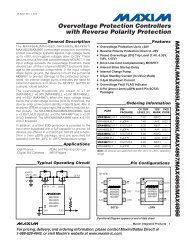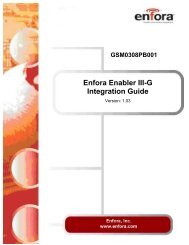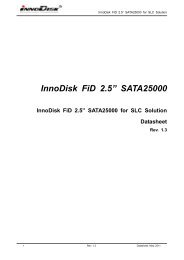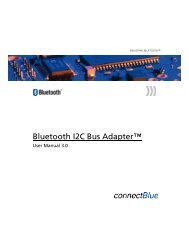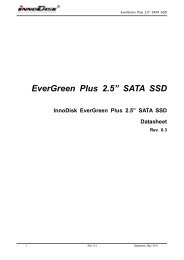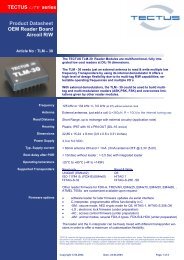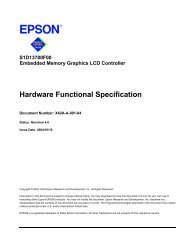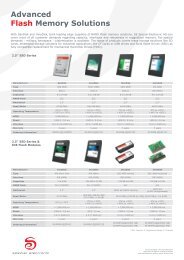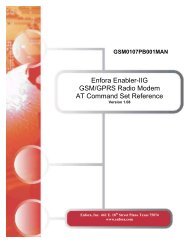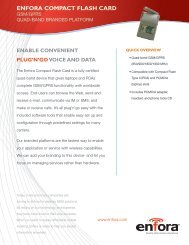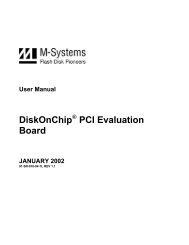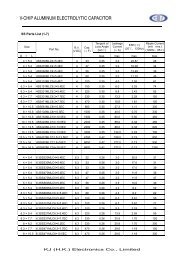AT+i Programmer's Manual - SE Spezial-Electronic AG
AT+i Programmer's Manual - SE Spezial-Electronic AG
AT+i Programmer's Manual - SE Spezial-Electronic AG
Create successful ePaper yourself
Turn your PDF publications into a flip-book with our unique Google optimized e-Paper software.
1 <strong>AT+i</strong> Command Set<br />
1.1 Scope<br />
<strong>AT+i</strong> Command Set<br />
This manual describes Connect One‘s <strong>AT+i</strong> interface standard, protocol, and syntax for<br />
the iChip CO2128.<br />
1.2 <strong>AT+i</strong> Command Guidelines<br />
<strong>AT+i</strong> commands are an extension to the basic AT command set. They are parsed and<br />
acted upon by iChip.<br />
iChip in dial-up mode only: When iChip is in COMMAND mode, basic AT commands<br />
and raw data (not prefixed by <strong>AT+i</strong>) are transparently transferred to the underlying<br />
modem Digital Communications Equipment (DCE), where they are serviced. When<br />
transferring data transparently to the DCE, the hardware flow control signals (CTS, RTS,<br />
DTR and DSR) are mirrored across the iChip, unless disabled by the FLW parameter. AT<br />
and <strong>AT+i</strong> commands may be issued intermittently. During an Internet session, when<br />
iChip is online, an AT command can be sent to the modem using the <strong>AT+i</strong>MCM<br />
command.<br />
The ASCII ISO 646 character set (CCITT T.50 International Alphabet 5, American<br />
Standard Code for Information Interchange) is used for issuing commands and responses.<br />
Only the low-order 7 bits of each character are used for commands and parameters; the<br />
high-order bit is ignored. Uppercase characters are equivalent to lowercase ones.<br />
1.3 <strong>AT+i</strong> Command Format<br />
An <strong>AT+i</strong> command line is a string of characters sent from the host to the iChip while it is<br />
in command state. The command line has a prefix, body, and terminator. Each command<br />
must begin with the character sequence <strong>AT+i</strong> and terminated by a carriage return .<br />
Commands can be entered either in uppercase or lowercase.<br />
iChip in dialup mode only: Commands that do not begin with the <strong>AT+i</strong> prefix are<br />
transferred to the underlying DCE, where they are parsed and acted upon. DCE responses<br />
are transparently returned to the host.<br />
The <strong>AT+i</strong> command body is restricted to printable ASCII characters (032–126). The<br />
command terminator is the ASCII character. The command line interpretation<br />
begins upon receipt of the carriage return character. An exception to this rule are the<br />
<strong>AT+i</strong>EMB, <strong>AT+i</strong>SSND, <strong>AT+i</strong>TBSN and <strong>AT+i</strong>FSND commands.<br />
When ECHO is enabled, the character is echoed as a two-character sequence:<br />
(Carriage Return+Line Feed).<br />
Characters within the <strong>AT+i</strong> command line are parsed as commands with associated<br />
parameter values.<br />
The iChip supports editing of command lines by recognizing a backspace character.<br />
When ECHO is enabled, the iChip responds to receipt of a backspace by echoing a<br />
backspace character, a space character, and another backspace. When ECHO is disabled,<br />
backspace characters are treated as data characters without any further processing.<br />
<strong>AT+i</strong> Programmer‘s <strong>Manual</strong> Version 8.21 1-1



